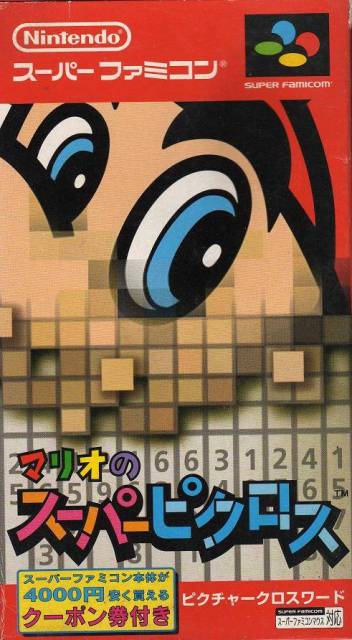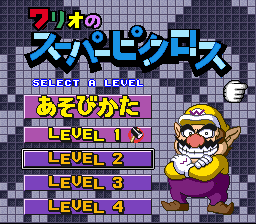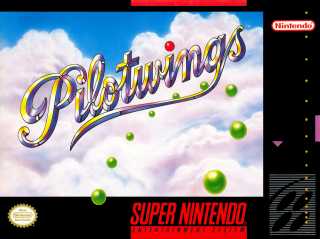The SNES Classic Mk. II: Episode III: Aeronauts & Crosses
By Mento 0 Comments
The SNES Classic had a sterling assortment of games from Nintendo's 16-bit star console, but it's hardly all that system has to offer a modern audience. In each installment of this fortnightly feature, I judge two games for their suitability for a Classic successor based on four criteria, with the ultimate goal of assembling another collection of 25 SNES games that not only shine as brightly as those in the first SNES Classic, but have equally stood the test of time. The rules, list of games considered so far, and links to previous episodes can all be found at The SNES Classic Mk II Intro and Contents.
Episode III: Aeronauts & Crosses
The Candidate: Nintendo/Jupiter's Mario's Super Picross

When I started this feature, I thought long and hard about SNES games that would still do favorably in today's marketplace. That usually meant looking for games that A) had an aesthetic - either in the art direction or actual graphical fidelity sense - that hadn't aged horribly, or B) were so distinctive and singular that they haven't yet been supplanted by a thousand iterative imitators in the interim. I neglected to consider that there are SNES games out there that are timeless because their genres haven't evolved - or, indeed, have needed to - since the 1990s. Picross (or nonograms, or picture logic, or paint-by-numbers) definitely falls into that category: while we've seen the popular picture puzzle try its hand with 3D, or multiple colors, or special limited abilities that do some of the guesswork for you, most Picross games made today still adhere to the standard 2D grid-like structure, presenting its numerical clues down both axes and giving the player some chill music to listen to as they take their time sussing out the pixel picture hidden within.
Picross became a fad for Japanese newspapers and magazines for a time during the 90s, and it wasn't long before Nintendo figured out how to get in on the act with a few Picross games headlined by their popular polymathic mascot Mario. The first of these was Mario's Picross, released for the Nintendo Game Boy in March 1995 - a perfect venue for a virtual approximation of the puzzles everyone was solving on the trains and busses to work - was the only one that saw an international release in its era. The second, which came six months later for Japan exclusively, was Mario's Super Picross for the Super Famicom.
The big difference between Mario's Super Picross and Mario's Regular Old and Busted Picross is that Super Picross offered two game modes: Mario mode and Wario mode. Rather than this affecting which puzzles they saw - though both have different sets, it's not like Wario gets nothing but pictures of farts and garlic or anything - it instead changed the rules. Mario mode was the buttoned-up, strait-laced, strict-for-your-own-good standard Picross ruleset that immediately penalizes you for mistakes, often adding time to the clock or making it impossible to earn a perfect score (though Mario's Super Picross doesn't actually track data like that, thankfully). Wario, meanwhile, didn't give a rat's ass. You can make as many errors as you want in his mode; he's not going to step in and tell you that you screwed up. This has a refreshing laissez-faire nature to it, but it's also subtly more difficult: if you make a mistake and don't realize it in time, you'll run into much bigger problems further along as the errors start to compound around this one faulty assumption. Because your supervisor is a lazy, good-for-nothing deadbeat like Wario, instead of the helpful and scrupulous Mario, you're left to make your own messes to clean up.

I vastly prefer the Wario system myself, largely because if I screw up because I read the board wrong that's my own cross to bear. If I mess up because I accidentally clicked the wrong box, or the right box with the wrong button, that feels less like an intellectual error that I ought to be punished for and more of a simple misclick that was no doubt the result of trying to expedite the early parts, quickly filling out or flagging all the obvious candidates so I can get to the meat of the puzzle faster. That Mario's Super Picross is one of very few Picross games with this option - another coveted rare recent example is Paint It Back! on Steam and mobile devices - elevates it the upper Picross pantheon in my view.
However, my one issue of complaint with this game and the major obstacle for its suitability for the SNES Classic Mk. II is that it doesn't feature very many Nintendo-focused puzzles. All of the game's puzzles I've seen so far - due to its nature, it's not really the type of game you can complete in one or two sittings - have been fairly generic Picross fare, with a surprising emphasis on fish of all things. I may have had better luck atempting to enter the lesser known but more Nintendo picture-focused Picross NP instead, which has a slightly bizarre release history you can read more about on its wiki page. As an episodic series released in an obscure manner, it wasn't suitable for international release at the time - by 1999/2000, it's not like a SNES game would've sold particularly well anyway - and likewise a bit of a strange case to stick on a SNES Classic device. In addition, its developers Jupiter have long since cannibalized most of the various Nintendo franchise-specific puzzles - Kirby, Mario, Zelda, Donkey Kong, etc. - in DLC packs for Picross DS and for their Picross e series for the 3DS eShop.
Part of me wishes that, if Nintendo Picross was to be included in the SNES Classic Mk. II line-up, Jupiter would find a way to hack apart the various games to create a Frankenstein's monster that keeps the ingenious rivalry of the Mario/Wario modes while ensuring that all the game's puzzles were drawn from Nintendo's rich visual history, in the vein of Picross NP.
- Preservation: The evergreen nature of Picross is what inspired me to include it for consideration. I will say that, without any kind of scorekeeping or rewards for fast/accurate play, there's not a whole to keep the game interesting in the long-term besides encountering more challenging puzzles, but perhaps that's enough. There's no real need to gameify Picross to a significant degree if the puzzles themselves are compelling enough. 4.
- Originality: Without the Nintendo-specific puzzles, the originality takes a big hit. What was once a relative novelty in a video game format has been evolved several times since 1995, including the aforementioned 3D of Picross 3D and ideas like creating a gigantic picture from multiple puzzles, or the abilities of Pokémon Picross. However, I think the dual Mario and Wario modes really add a lot of variance to how you approach the game that few of its successors, spiritual or otherwise, ever thought to include. 3.
- Gameplay: In pure Picross terms, the game is a little outdated in a few quality-of-life respects. For one, a column of number clues won't gray out once you've solved that row, which is always a handy visual shortcut for how much progress you still need to make. Only the Mario challenges are timed, and you have 30 minutes (though it disappears quickly if you keep making mistakes), and there's a dearth of other options. It's just some standard-ass Picross, for better or worse. 4.
- Style: Mario and Wario are technically headlining this game, but you don't see much of either of them outside of the menus and some congratulatory screens after each of the 12-puzzle "chapters" are complete. All they do is stand there and yell things in Japanese, though, so we're not talking amusing Pac-Man style vignettes between Mario/Wario and other denizens of the Mushroom Kingdom. Hard to say what you might feasibly expect from the presentation of a Picross game. You do get little animations for some (not all) the completed puzzles though, which is cute. 3.
Total: 14.
Other images:
The Nominee: Nintendo EAD's Pilotwings

Last episode, we explored the bizarre decision to leave Chrono Trigger off the SNES Classic, taking into account its status as one of the most beloved SNES JRPGs, its enduring popularity the result of its imaginative premise, its relatively svelte run-time, and its many mechanical innovations, such as a lack of random encounters and team-up special attacks. Well, Pilotwings is slightly less beloved, but I would still argue that its absence on the SNES Classic Mk. I is every bit as conspicuous. Along with Super Mario World and F-Zero, Pilotwings was a SNES launch title (or close enough in Japan) intended to demonstrate the various capabilities of the new system's hardware, not just with the introduction of dazzling 16-bit graphics but the system's snazzy new sprite-scaling features, including the inimitable "Mode 7". It was an internationally famous SNES game developed in-house at Nintendo's EAD branch and one of their few new IPs for the system, making it one of the more identifiable faces of the Super Nintendo Entertainment System both during the promotional push around the system's launch and later on when it came time for SNES eulogies with the advent of the CD-ROM era, and the nostalgia pieces that followed years after that. You know, like this one.
However, there would be no Pilotwings for the SNES Classic Mk. I. Despite a couple of sequels, the most recent of which was Pilotwings Resort for DS in 2011, Nintendo didn't feel like the once pioneering "flight simulator for dummies" deserved a spot on their retro celebratory system. It was one of those seminal SNES titles that, while not everyone was excited to play it again, it was widely expected by anyone putting together a list of their predicted titles for the SNES Classic, long before it was even announced.

For the uninitiated, Pilotwings is a mini-game collection in which each mini-game was based around some sort of aerial activity. Airplanes, skydiving, jetpacks, and hang-gliding were the main events, and each new chapter of the game had the player take an examination for three or four of them simultaneously, with the goal being to score well enough cumulatively to pass the qualifying amount and graduate. After graduating, the player moves up a pilot class, and is given even harder challenges to complete. A player's success at the game depended largely on their flexibility, as they couldn't flub the one event they were bad at and still expect to make the stringent passing score required: instead, they would often prioritize their lesser events and hopefully do well enough at them that their stronger pursuits could carry them over the finishing line. It certainly wasn't an easy game, but that challenge helped buoy what was a relatively short run-time all-told. (The post-game special missions, in which the player took to the skies in an attack helicopter dropping bombs on various ground-to-air turrets, were even less forgiving.)
At the same time, the skydiving in particular seemed to burrow itself into the public consciousness of what the SNES was and the types of new experiences it could offer over its predecessor and rivals Sega. The vertiginous Mode 7 made it seem the Earth was rushing to meet you as you tried to angle yourself to hit the various rings of yellow lights on the way down to your destination, and then the frantic correcting and overcorrecting of your parachute descent to hit that most elusive of targets: the moving bullseye, which floated around the moat that surrounded the more pedestrian static landing zone for casuals, taunting you with its alacrity. More so than bashing into F-Zero's futuristic barriers on every turn or dismounting Yoshi to assault a Koopaling's castle, that Mode 7 parachuting game made the most lasting impression of the early SNES era in my mind, back when I was still being floored by what the SNES could do. It's a shame that Nintendo didn't agree. Then again, maybe Pilotwings was never that great to begin with? Let's check:
- Preservation: As much as I hate to admit it, Mode 7 hasn't held up as well as most of us would like to believe. Like the Sega Genesis sound chip, it lives on our hearts because of its endearing flaws and limitations, though I can't for the life of me imagine how some modern-day tot would approach it as anything more than an archaic assault on the senses. There aren't that many console games that let you play skydiving and jetpack mini-games, though, so the game still has some historical value in that regard. 3.
- Originality: Besides its sequels, how many "casual" flight simulators are there? The genre has become more streamlined and accessible as the years have rolled on, partly for their own survival (outside of the deliberately niche stuff like Digital Combat Simulator) and partly because that's the direction all genres have moved towards as the audience for games has continued to expand, but Pilotwings was really the first to give you an airplane to fly and not make it a stressful nightmare of dials and switches that required a @drewbert-style 50 page printed PDF for all your preparations. It was a great distillation of a predominantly PC genre that a console audience could approach without collapsing into the fetal position after a few minutes of trying to check the engine's oil pressure. 4.
- Gameplay: In being unnecessarily stringent, Pilotwings was often a frustrating exercise in last-second failure, as you could power through two of the three before crashing and burning horribly (and literally) because of a mis-timed landing. While an effort was made to translate the various activities to a console-friendly format, it still took some finesse before you could make the plane move how you'd prefer, or accurately make a skydiving landing by feathering the approach the correct way without falling too quickly. To its credit, the jetpacking in Pilotwings has always been the most intuitive thing, conversely. Beyond that, there's not much more "game" here: it's the most "tech-demo"-y of the North American/European SNES launch library. 3.
- Style: The issue with Pilotwings is that it's perhaps a little too dry with its presentation. Pilotwings 64 and Resort made huge strides in giving their respective aviator tomfoolery sims a really distinctive look and personality, with 64 in particular invoking a more comedic vein that often made jokes at the expense of the various playable characters: the buff and impressively-mustachioed Hawk, for instance, has an enormous metal doppelganger that becomes a boss in one of the helicopter challenges. SNES PIlotwings lacks any similar degree of stylistic bells and whistles beyond the wonderful flat world of Mode 7, with the few moments of levity coming from the expressions of your instructors - either exasperated at your incompetence or astounded at your proficiency. 3.
Total: 13.
Other images:









